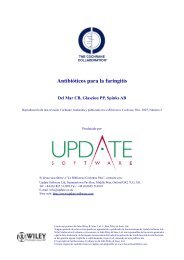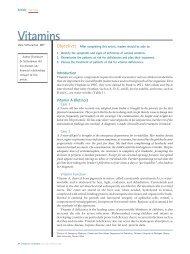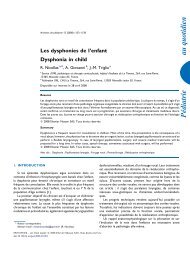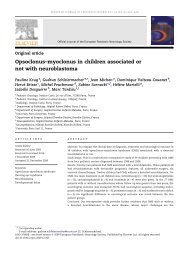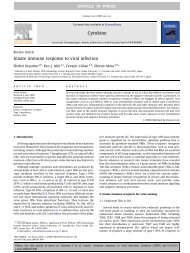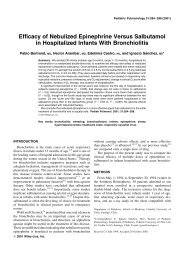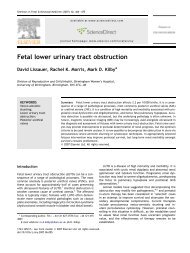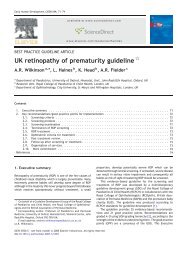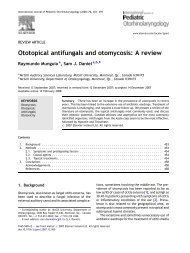Acute Idiopathic Thrombocytopenic Purpura of Childhood ... - sepeap
Acute Idiopathic Thrombocytopenic Purpura of Childhood ... - sepeap
Acute Idiopathic Thrombocytopenic Purpura of Childhood ... - sepeap
Create successful ePaper yourself
Turn your PDF publications into a flip-book with our unique Google optimized e-Paper software.
Pediatric Emergency Care Volume 21, Number 10, October 2005<br />
<strong>Acute</strong> <strong>Idiopathic</strong> <strong>Thrombocytopenic</strong> <strong>Purpura</strong><br />
TABLE 1. Treatment for <strong>Acute</strong> <strong>Idiopathic</strong> <strong>Thrombocytopenic</strong> <strong>Purpura</strong><br />
Treatment<br />
Dosing<br />
Time to Increase<br />
in Platelet Count<br />
Observation N/A 3–4 wk N/A<br />
Corticosteroid<br />
Traditional dose<br />
1–2 mg/kg per<br />
d for 7–21 d<br />
Complications<br />
<strong>of</strong> Treatment<br />
3–10 d Behavioral changes,<br />
glucosuria, hypertension,<br />
osteopenia, increase in<br />
appetite and weight gain<br />
High dose 4 mg/kg per d for 4 d 2–4 d<br />
IVIg 0.8–1 g/kg IV for 1–2 d 24 h Fever, nausea, vomiting,<br />
chills, headache, aseptic<br />
meningitis<br />
Anti-D immunoglobulin 50–75 mg/kg IV for 1–2 d 24–48 h Fever, nausea, vomiting,<br />
chills, myalgias, hemolysis<br />
N/A indicates not applicable.<br />
corticosteroids includes decreased clearance <strong>of</strong> the antibodyplatelet<br />
complex and impaired phagocytosis <strong>of</strong> platelets. 27–31<br />
Early studies <strong>of</strong> corticosteroids used to treat acute ITP<br />
showed that there was some benefit when given in low doses<br />
over longer periods compared with placebo. This traditional<br />
dosing was 1 to 2 mg/kg <strong>of</strong> oral prednisone per day for 1 to 3<br />
weeks. 32,33 Time to an increase in platelet count varied from<br />
3 to 10 days. This dose is well tolerated and not usually<br />
associated with significant side effects if it is tapered or<br />
discontinued within a month. However, this is not commonly<br />
used at presentation <strong>of</strong> acute ITP because <strong>of</strong> the longer time<br />
it takes to see platelet recovery. Higher dose steroids given<br />
for a short period have recently been shown to be effective at<br />
raising the platelet count within 2 to 4 days. 34–36 The dose <strong>of</strong><br />
corticosteroids given varied across the studies and ranged<br />
between 4 mg/kg per day to 30 mg/kg per day <strong>of</strong> prednisone<br />
or methylprednisolone for up to 4 days. There were no undue<br />
side effects noted when a dose <strong>of</strong> 4 mg/kg per day for 4 days<br />
orally was used. 34<br />
The benefits <strong>of</strong> using corticosteroids are the relative<br />
ease <strong>of</strong> administration in an outpatient or inpatient setting,<br />
the low cost compared with other treatments, and the absence<br />
<strong>of</strong> exposure to human plasma. The longer time to platelet<br />
increase, however, precludes the use <strong>of</strong> steroids alone to treat<br />
patients who may have moderate or more severe bleeding<br />
symptoms at presentation. High-dose corticosteroids are<br />
effective initial therapy for acute ITP and are used with some<br />
frequency. The Intercontinental <strong>Childhood</strong> ITP Study Group<br />
reported recently that approximately 25% to 40% <strong>of</strong> children<br />
in their registry received corticosteroids as initial therapy<br />
when they presented with acute ITP. 1 The relationship <strong>of</strong><br />
bleeding symptoms or dose <strong>of</strong> corticosteroids used was not<br />
presented in this observational study.<br />
Intravenous Ig<br />
The third treatment option is intravenous (IV)Ig. IVIg<br />
is thought to work, in part, by causing a temporary but<br />
prolonged blockade <strong>of</strong> the Fc receptor <strong>of</strong> the phagocyte that<br />
mediates immune clearance. 31,37,38 This blockade leads to a<br />
compensatory increase in the platelet count. Recently, IVIg<br />
has been shown in a mouse model to more specifically act by<br />
causing up-regulation <strong>of</strong> the inhibitory receptor FcgRIIb to<br />
cause blockade <strong>of</strong> Fc receptors on splenic macrophages. 39,40<br />
There are a variety <strong>of</strong> doses <strong>of</strong> IVIg that may be used, but,<br />
most commonly, the dose given is 0 .8 to 1.0 g/kg daily for 1 to<br />
2 days. 41–45 Given at this dose, IVIg leads to a rapid increase in<br />
platelet count as early as 24 hours after infusion and has been<br />
effective when used for moderate or severe bleeding in acute<br />
ITP. The side effects associated with IVIg are fever, chills,<br />
headache, nausea, vomiting, and aseptic meningitis. There is<br />
also the small risk <strong>of</strong> an infectious complication as IVIg is an<br />
albumin-containing product. Most <strong>of</strong>ten, IVIg, which is<br />
usually administered over 4 to 6 hours or more, is given in a<br />
hospital setting and requires more resources and cost to<br />
administer than corticosteroids. However, it is commonly<br />
used at first presentation <strong>of</strong> acute ITP.<br />
Anti-D Ig<br />
Anti-D Ig, which is purified human IgG directed at the<br />
erythrocyte D antigen, has more recently been used to treat<br />
acute ITP in children who are nonsplenectomized and who<br />
have rhesus-positive (Rh + ) red blood cells. 43,46,47 The<br />
mechanism <strong>of</strong> action <strong>of</strong> anti-D is similar to IVIg in that it<br />
decreases the clearance <strong>of</strong> platelets. More specifically, anti-D<br />
binds to the Rh + red blood cell and sensitizes it to bind to the<br />
macrophage Fc receptor and thereby promotes its clearance by<br />
the spleen. 31,48 This frees platelet-antibody complexes from<br />
being trapped. 48 Higher doses <strong>of</strong> anti-D (50–75 mg/kg) have<br />
been shown to be the most effective at increasing the platelet<br />
count within 24 to 48 hours similar to IVIg. 46,47,49,50 Anti-D is<br />
given IV over 15 to 30 minutes and thus can be easily administered<br />
in an outpatient or emergency department setting. It<br />
has also been shown to be less costly than an equivalent dose<br />
<strong>of</strong> IVIg. 51 The side effects <strong>of</strong> anti-D include headache, fever,<br />
chills, nausea, and vomiting and myalgias. 52 In addition, anti-<br />
D causes hemolysis and a transient decrease in the hemoglobin<br />
n 2005 Lippincott Williams & Wilkins 693<br />
Copyright © Lippincott Williams & Wilkins. Unauthorized reproduction <strong>of</strong> this article is prohibited.




